|
|
|
 |
 |

 |
 |
Analysis by IRSN of the Fukushima Daiichi accident of March 2011
Institut de Radioprotection et de Sûreté Nucléaire (IRSN), 2013, video
On March 11, 2011, the earthquake that occurred off the eastern coast of the Island of Honshu in Japan and the ensuing tsunami devastated the Japanese territory in the Tohoku region, causing widespread destruction of local infrastructures and untold suffering for the local population.
The natural catastrophe also caused major damage to the Fukushima Dai-ichi Nuclear Power Plant, which led to a core |
meltdown in three nuclear reactors and loss of cooling for several fuel storage pools. Large amounts of radioactive materials were released into the environment. The accident was rated Level 7 on the International Nuclear Event Scale.
Beginning on March 11th, IRSN took action to analyze the ongoing crisis and the probable radiological consequences of the nuclear accident, in order to provide the President of France, the French authorities and competent agencies, the Nuclear Safety Authority, elected officials and the French Ambassador to Japan with up-to-date information during the critical phases of the accident.
IRSN has also performed an extensive analysis of the supplementary safety reviews recently conducted on French nuclear facilities in order to draw the initial conclusions concerning the accident.
A more in-depth analysis of the events that took place is still necessary however, to obtain more precise operational feedback about the events. This film has been made to help viewers better understand the events that took place at Fukushima. In its current version, the film focuses entirely on the events that resulted in a core meltdown in three of the reactors at Fukushima. The management of the cooling systems for the fuel storage pools, the impact of the accident on plant employees, on the local population and on the environment, are not covered in the film.
youtube | Français
Extraído de:
http://www.irsn.fr/EN/publications/thematic/fukushima/Pages/video-fukushima-2-years-later.aspx
|
 |
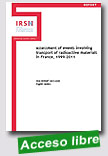 |
Assessment of events involving transport of radioactive materials in France, 1999-2011
Institut de Radioprotection et de Sûreté Nucléaire (IRSN), 2013, 32 p.
In its role of technical support of the authorities for safety and protection against radiations, IRSN has a mission of assessment that covers the design, the manufacturing, the testing and the use of packaging and transport system. It also takes part in the emergency response in the event of anomalies, incidents or accidents (known in a generic way as “events”). To assist with this work, IRSN manages a database that lists all events reported for transport.
|
IRSN publishes a new report about transport events involving radioactive materials that occurred in France from 1999 to 2011. For each of the 1 304 events recorded, many parameters have been collected and analysed from information listed in the declarations and reports of events sent by users (type of event, purpose, package design, INES level, etc.).
The number of events declared in 2010 and 2011 is slightly higher than the average of 100 events per year. The two main reasons for declaration concern errors in transport documentation or labelling and handling mishaps. The new data confirm the downward trend in frequency of package and vehicle contaminations. A short description of outstanding events in 2010 and 2011 is included. This assessment also gives an outline of the actions recommended by IRSN to avoid recurrence of declared events and improve the safety of radioactive material transport.
Français
Extraído de:
http://www.irsn.fr/EN/newsroom/News/Pages/20130322-Transport-of-radioactive-materials-IRSN-draws-lessons-from-events-reported-between-1999-and-2011.asp
|
 |
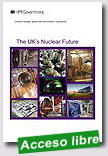 |
Nuclear Industrial Strategy: The UK's Nuclear Future
HM Government (UK), 26 March 2013, 91 p.
The Nuclear Industrial Strategy identifies priorities that government and industry will work on together in a long-term partnership. It aims to provide more opportunities for economic growth and creating jobs through an increased share of all aspects of the nuclear market. It covers:
opportunities in the nuclear new build programme waste management and decommissioning
operations and maintenance associated professional services, both in the UK and in overseas markets.
|
The Strategy includes: a new Nuclear Industry Council, that bring together all the key players across the nuclear supply chain; better coordination of research and development (R&D) and innovation through new bodies: the Nuclear Innovation and Research Advisory Board and a Nuclear Innovation and Research Office; a cost reduction initiative to investigate the scope for reducing costs across all aspects of the nuclear industry; a long-term plan to ensure we will have the skills required for the future.
The new Nuclear Industry Council will own of this Strategy, driving forward the work programmes and keeping it current.
Extraído de: https://www.gov.uk/government/publications/nuclear-industrial-strategy-the-uks-nuclear-future
|
 |
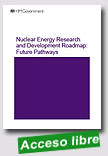 |
Sets out research and development (R&D) activities and illustrative timelines which would support implementation of a number of future nuclear technology pathways: Baseline Pathway: no new build, operating the existing reactor fleet for the remainder of its life, decommissioning and clean-up of sites in the UK and delivery of a geological disposal facility; Open Fuel Cycle Pathway: delivery of 16 gigawatts (GW) of new nuclear |
build capacity by 2025, followed by up to 75 GW with an open fuel cycle by 2050, and the elements of the Baseline Pathway; Closed Fuel Cycle Pathway: delivery of 16 GW of new nuclear build capacity by 2025, followed by up to 75 GW with a closed fuel cycle by 2050, and the elements of the Baseline Pathway.
This document aims to inform decisions on future technologies.
Extraído de:
https://www.gov.uk/government/publications/nuclear-energy-research-and-development-roadmap-future-pathways
|
 |
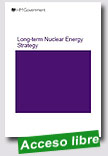 |
Long-term Nuclear Energy Strategy
HM Government (UK), 26 March 2013, 31 p.
The government believes that nuclear energy has an important role to play to deliver our long term objective of a secure, low carbon, affordable, energy future. For nuclear energy to reach its full potential, we must meet significant challenges in the short term and for the longer term to 2050 and beyond.
This document sets out the government’s vision for the future of nuclear energy in the UK, and our strategy to ensure nuclear has the best prospect of reaching its full potential provides a clear
|
framework to assess decisions and priorities for policy and research against in a coordinated manner, guiding the development of detailed plans and actions explains the role of nuclear power in the UK electricity mix and the role of the UK nuclear sector in the global economy, identifying key priorities the government’s role in implementing its vision.
Extraído de:
https://www.gov.uk/government/publications/long-term-nuclear-energy-strategy
|
 |
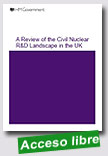 |
A Review of the Civil Nuclear R&D Landscape in the UK
HM Government (UK), 2013, 109 p.
In November 2011, the House of Lords Select Committee on Science and Technology published the report of their Inquiry into Nuclear Research and Development (R&D) Capabilities in the UK. The report identified a number of serious shortcomings in the UK nuclear R&D landscape and recommended change in a number of areas, including the level of funding allocated to support nuclear R&D in the UK.
In February 2012, the Government’s response to the Select
|
Committee’s report set out a programme of work to address the report’s recommendations. One part of that programme is a review of the current nuclear R&D landscape in the UK that can inform decisions on the scope, shape and size of the R&D landscape needed for the future.
This review looks at the complete civil nuclear R&D landscape in the UK, from Government policies that give rise to research needs, through existing funding sources that support R&D, to the capability of the UK’s research base in the UK to meet the demands of Government and the private sector. This review is part of an integrated package of documents which, taken together, will ensure that a new long-term nuclear energy policy in the UK is optimally underpinned by R&D.
Extraído de:
https://www.gov.uk/government/uploads/system/uploads/
attachment_data/file/168039/13-631-a-review-of-the-civil-
nuclear-r-and-d-landscape-review.pdf |
 |
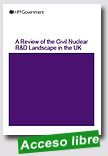
|
The economic benefit of the improving the UK's nuclear supply chain capabilities
Oxford Economics, March 2013, 122 p.
This study by Oxford Economics and Atkins, quantifies some of the potential economic impacts associated with developing the capabilities of the UK's nuclear supply chain.
The study takes place against the backdrop of the UK Government's policy that new nuclear should be able to contribute as much as possible to the need for new low carbon electricity generating capacity. It is recognised that industry has
|
already set out its plans to develop approximately 16GW of new nuclear power in the UK. Developments of this scale would present significant opportunities in the UK nuclear sector from which the UK supply chain can benefit. The UK Government has therefore stated its commitment to ensuring that the new nuclear build programme not only delivers much of new generating capacity required but also that it delivers economic benefits to the UK including ensuring the nuclear supply chain is well positioned to access UK and long term export markets.
As a result of the policy aims with respect to new nuclear, the objectives of this study were to provide: a short review of current UK capabilities to be informed by industry consultations and a review of the literature; international case studies; an assessment of a range of potential levels of domestic content within new nuclear projects in UK; a bottom-up net cost-benefit analysis of scenarios in which UK economic activity is increased above the baseline; and
an indicative cost-benefit analysis of policies contained in the Nuclear Supply Chain Action Plan.
In this study we define the UK's supply chain capabilities as any work that can be undertaken within the UK.
The economic benefit of the improving the UK's
nuclear supply chain capabilities: data underlying charts and tables
Extraído de:
https://www.gov.uk/government/uploads/system/uploads/attachment_
data/file/168017/bis-13-633-the-economic-benefit-of-improving-the-uk-
nuclear-supply-chain-capabilities.pdf
|
 |
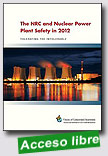 |
The NRC and Nuclear Power Plant Safety 2012 Report: Tolerating the Intolerable
Union of Concerned Scientists, March 2013, 74 p.
When a safety net breaks, you don't simply treat the injuries suffered by the unlucky performers. You fix the net.
This analogy serves as the starting point for The NRC and Nuclear Power Plant Safety in 2012: Tolerating the Intolerable, our third annual review of the Nuclear Regulatory Commission's performance in policing the U.S. nuclear power industry. The report takes the NRC to task for its failure to consistently enforce |
its own regulations, effectively leaving long-term holes in the safety net that is supposed to protect the public from the inherent hazards of nuclear power.
According to the report, the NRC's lax oversight "reflects a poor safety culture," including a disconnect between the agency's workforce and its senior management, with managers tending to downplay safety problems and react negatively when workers point them out.
Executive summary
Extraído de:
http://www.ucsusa.org/nuclear_power/nuclear_power_risk/safety/nrc-and-nuclear-power-safety-annual.html
|
 |
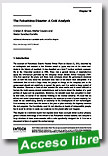 |
The Fukushima Disaster: A Cold Analysis
In: Current Research in Nuclear Reactor Technology in Brazil and Worldwide - In Tech, February 06, 2013, 34 p.
The accident of Fukushima Daiichi Nuclear Power Plant on March 11, 2011, followed by an earthquake and tsunami at the Honshu island of Japan was one of the worst accidents in the history of mankind. It was classified as a level 7 nuclear accident, comparable to the Chernobyl accident in 1986. There was a general feeling of dissatisfaction about the information provided by the company Tokyo Electric Power Company |
(TEPCO), that operated the plant, and there were criticisms about the government decisions and on how the data about the measured dose rates in the island were interpreted. It is understood that in such a huge crisis, the people at charge in the company and in the government should not contribute to spread the panic, and it is useful to keep control of the situation. However, a flood of data invaded the news media and it turned difficult to harvest the truth among several contradictions, and to know about the destiny of a good portion of Japan and its population. Moreover, we scientist must feel compelled to clarify that truth, no matter if not directly working in the nuclear industry. We must feel an ethical and moral commitment to understand the situation in such a human calamity, because we are contributing directly or indirectly to the development of new technologies. It is necessary to learn from the errors of the past to plan carefully the highway towards the real progress. Our knowledge must be not abandon in hands of irresponsible people, but it must be driven to make our existence in this planet safer and happier.
This chapter is a technical report that exposes some basic concepts about nuclear physics, gives a concise chronology of the events at the Fukushima nuclear disaster, and analyzes a large database of dose measurements with a code specifically designed for it. It is not a document in favor or against the nuclear energy.
Complete report
Extraído de: http://www.intechopen.com/download/pdf/42428
|
 |
|
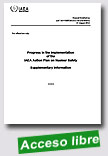
|
Progress in the Implementation of the IAEA Action Plan on Nuclear Safety -Supplementary Information
IAEA, 15 August 2012, 41 p.
The draft IAEA Action Plan on Nuclear Safety (the Action Plan) built on the Declaration of the IAEA Ministerial Conference in June 2011, the conclusions and recommendations of the three
conference working sessions of this Conference, the IAEA Fact Finding Mission to Japan and the 2011 INSAG Letter Report to the Director General. The draft Action Plan was adopted by the Board of Governors at its September 2011 meeting and was |
endorsed by all 151 Member States at the 2011 IAEA General Conference. The ultimate goal of the Action Plan is to strengthen nuclear safety, emergency preparedness and radiation protection of people and the environment worldwide.
The Nuclear Safety Action Team established in 2011, immediately after the adoption of the Action Plan, identified and developed 170 specific activities to respond to the 12 actions and 39 subactions contained in the Action Plan, with around 650 detailed tasks to implement the Secretariat’s activities in the light of the accident at TEPCO’s Fukushima Daiichi Nuclear Power Station (the Fukushima accident). An overview of these activities was provided to the Member States at an informal briefing held in January 2012.
The Secretariat has launched an Action Plan web site as well as an Action Plan platform in which it provides further information on the Secretariat’s activities under the Action Plan and updates on the situation in TEPCO’s Fukushima Daiichi Nuclear Power Station (the Fukushima Daiichi NPP), as well as information relating to emergency preparedness, the international legal framework and access to other pertinent documents. The web site provides general information for the public and the web platform provides more detailed information for Member States.
The IAEA Director General has submitted reports on the progress on the implementation of the Action Plan at the November 2011, and at the March, June and September 2012 Board of Governors meetings, respectively. This document provides supplementary information to the Report of the Director General on Progress in the Implementation of the Action Plan on Nuclear Safety contained in GOV/INF/2012/11-GC(56)/INF/5.
Extraído de: http://www.iaea.org/About/Policy/GC/GC56/GC56InfDocuments/English/gc56inf-5-att1_en.pdf |
|
|
|
|
|
|
